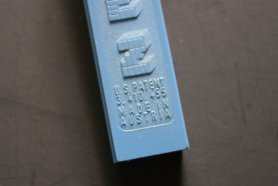One of the things that I remember having around during my childhood is a PEZ dispenser. The Hulk, Garfield and even Spiderman were some of the dispensers that I had, and nothing could beat that cherry flavored candy.
PEZ candy was first produced in Vienna, Austria in 1927. The candy was first advertised as a compressed peppermint sweet, and PEZ is actually an abbreviation for PfeffErminZ (that’s German for peppermint). These candies came in a tin that looks like what Altoids come in today.
When the dispensers came about, they were not always called that. They were called “regulars”, and they looked a lot like a cigarette lighter. They dispensed an adult breath mint that were marketed as an alternative to smoking.
When 1955 rolled around, the dispensers started to have character heads on them, and this happened after PEZ was introduced in the United States. One example of these character heads is this POLICEMAN dispenser.

As you can see, the dispenser should have a police hat on it, but has been lost over time. Over the years, PEZ has made dispensers with and without feet.

As you can tell from the picture above this great example has no feet, and you can see this dispenser in my Etsy store here.
What kind of PEZ dispensers have you had?



